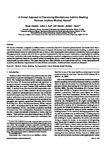A formal approach to discovering simultaneous additive masking between auditory medical alarms
| dc.contributor.author | Hasanain, B | |
| dc.contributor.author | Boyd, AD | |
| dc.contributor.author | Edworthy, Judy | |
| dc.contributor.author | Bolton, ML | |
| dc.date.accessioned | 2016-10-03T13:47:42Z | |
| dc.date.available | 2016-10-03T13:47:42Z | |
| dc.date.issued | 2017-01 | |
| dc.identifier.issn | 0003-6870 | |
| dc.identifier.issn | 1872-9126 | |
| dc.identifier.other | C | |
| dc.identifier.uri | http://hdl.handle.net/10026.1/5549 | |
| dc.description | publisher: Elsevier articletitle: A formal approach to discovering simultaneous additive masking between auditory medical alarms journaltitle: Applied Ergonomics articlelink: http://dx.doi.org/10.1016/j.apergo.2016.07.008 content_type: article copyright: © 2016 Elsevier Ltd. All rights reserved. | |
| dc.description.abstract |
The failure of humans to respond to auditory medical alarms has resulted in numerous patient injuries and deaths and is thus a major safety concern. A relatively understudied source of response failures has to do with simultaneous masking, a condition where concurrent sounds interact in ways that make one or more of them imperceptible due to physical limitations of human perception. This paper presents a method, which builds on a previous implementation, that uses a novel combination of psychophysical modeling and formal verification with model checking to detect masking in a modeled configuration of medical alarms. Specifically, the new method discussed here improves the original method by adding the ability to detect additive masking while concurrently improving method usability and scalability. This paper describes how these additions to our method were realized. It then demonstrates the scalability and detection improvements via three different case studies. Results and future research are discussed. | |
| dc.format.extent | 500-514 | |
| dc.format.medium | Print-Electronic | |
| dc.language | en | |
| dc.language.iso | en | |
| dc.publisher | Elsevier BV | |
| dc.subject | Medical alarms | |
| dc.subject | Masking | |
| dc.subject | Psychoacoustics | |
| dc.subject | Formal methods | |
| dc.subject | Model checking | |
| dc.title | A formal approach to discovering simultaneous additive masking between auditory medical alarms | |
| dc.type | journal-article | |
| dc.type | Journal Article | |
| plymouth.author-url | https://www.webofscience.com/api/gateway?GWVersion=2&SrcApp=PARTNER_APP&SrcAuth=LinksAMR&KeyUT=WOS:000384776100056&DestLinkType=FullRecord&DestApp=ALL_WOS&UsrCustomerID=11bb513d99f797142bcfeffcc58ea008 | |
| plymouth.volume | 58 | |
| plymouth.publication-status | Published | |
| plymouth.journal | Applied Ergonomics | |
| dc.identifier.doi | 10.1016/j.apergo.2016.07.008 | |
| plymouth.organisational-group | /Plymouth | |
| plymouth.organisational-group | /Plymouth/Faculty of Health | |
| plymouth.organisational-group | /Plymouth/Research Groups | |
| plymouth.organisational-group | /Plymouth/Research Groups/Centre for Brain, Cognition and Behaviour (CBCB) | |
| plymouth.organisational-group | /Plymouth/Research Groups/Centre for Brain, Cognition and Behaviour (CBCB)/Behaviour | |
| plymouth.organisational-group | /Plymouth/Users by role | |
| dc.publisher.place | England | |
| dcterms.dateAccepted | 2016-07-18 | |
| dc.rights.embargodate | 2017-8-29 | |
| dc.identifier.eissn | 1872-9126 | |
| dc.rights.embargoperiod | 12 months | |
| rioxxterms.versionofrecord | 10.1016/j.apergo.2016.07.008 | |
| rioxxterms.licenseref.uri | http://www.rioxx.net/licenses/under-embargo-all-rights-reserved | |
| rioxxterms.licenseref.startdate | 2017-01 | |
| rioxxterms.type | Journal Article/Review |


